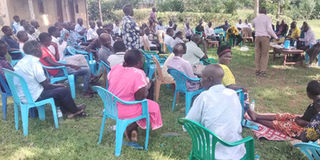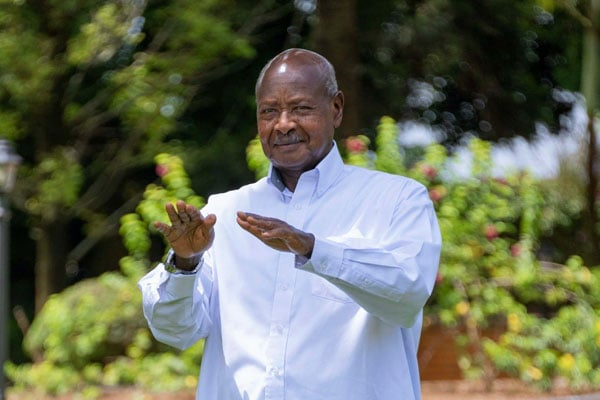Prime
Encroachers descend on Busitema forest

Some of the community members attend a sensitisation meeting on environmental conservation organised by Tororo District Local Government under the Farm Income Enhancement and Forestry Conservation project at the weekend. Photo/Joseph Omollo
What you need to know:
The leaders say locals are cutting down trees in Busitema Forest Reserve which they sell to earn a living
For decades, the majestic Busitema Forest Reserve in eastern Uganda stood pristine, unperturbed by human activities.
The forest, which is shared by Busia, Bugiri and Tororo districts, is filled with a wide variety of tree and animal species, which draw hundreds of tourists to marvel at its beauty.
But this has since changed. The forest, like many others in the country, has been encroached on by the locals who are cutting down its trees and turn them into poles, timber and charcoal and sell to earn a living.
The Tororo District natural resources officer, Mr Sailos Anguti, says in 1998, the forest’s deforestation rate stood at two percent.
After some intervention by the district leaders it reduced to one in 1999 but in 2020, due to population pressure and high demand for charcoal it accelerated to four percent.
He adds that the state of the natural forests currently stands at only 30 percent of the forestland in Uganda or about 1.5 million hectares.
With deforestation estimated at one percent per annum, this may be reduced to about 1.2 million hectares in the coming few years from now.
The Busia District chairman, Mr Stephen Wasike Mugeni, says the lack of adequate land for cultivation and settlement has driven the locals to encroach on natural resources.
“If nothing is done, the damage will keep increasing and some years to come, the forest may face extinction because of the massive encroachment,” he said.
He named the affected areas in the district as Wamusi, Butongi, Sidimbir A and B villages in Bulumbi Sub-county and Hamasanja Parish in Busiteme Sub-county.
“It is on record that the high levels of poverty push the locals to encroach on the forest for survival like cutting trees for charcoal burning and other human activities,” he says.
The Pallisa LC5 chairman, Mr Patrick Duchu, said the high rate of destruction of forests has had adverse effects on the climate and thus causing persistent droughts and low food production.
“This causes a threat of floods that at times sweep away homes and crops leaving many households in dire food shortage,” he said.
Mr Robert Opolot, a resident of Busia Municipality, agrees, saying: “This is the reason why we are experiencing erratic rainfall, drought or at times floods in some areas.”
Mr Cyprian Kamwada, the Budaka District natural resource officer, says many people are encroaching on natural resources, adding that 94 percent of the population in the district has encroached on wetlands where they are earning their livelihood.
He adds that the declining capacity for wetlands to provide essential critical ecosystems has resulted in increased flooding, silting of water bodies, increased water treatment costs, increased conflict, reduced productivity and increased greenhouse gas emissions.
“With support from development partners, we have started restoring depleted wetlands and also providing alternative livelihoods to the affected communities,” he said.
According to the Uganda Bureau of Statistics, about 88.3 percent of the households in the district (which has 98 parishes) and Bukedi Sub-region at large depend on subsistence farming as the main source of livelihood.
Poverty
The current poverty rate in the district is 43.7 percent with a Gross Domestic Product (GDP) per capita of less than $135 (Shs500,000) in the sub-region. The sub-region comprises Pallisa, Budaka, Butebo, Butaleja, Tororo and Busia.
The Third National Development Plan (NDPIII) poverty reduction projections for the sub-region stands 25.8 percent by 2025.
Environmental experts have warned that Uganda’s rapid population growth which was estimated at 47.2 million in 2022 and growing at three percent per annum has serious implications on the environment.
They say this will increase the demand for food, shelter and other social services, which may inturn cause the locals to encroach on natural resources.
The Busia District forestry officer, Mr Jimmy Ngolobe, says they are sensitising the communities about the dangers of encroaching on forests.
“We are also sensitising communities to plant trees to mitigate the effects of climate change,” he says.
Mr Anguti says there is a need to slow the pace of climate change, preserve wildlife and support the growing human population.
He says the district has set up the Farm Income Enhancement and Forestry Conservation Project to address some of the issues raised above.
“Under this arrangement, more than one million trees have been planted on road reserves and gazetted wetlands. The tree species planted include pines, eucalyptus and gravila,” he says.
Posuna wetland in Magola Sub-county and Kasipodo wetland in Kayoro Sub-county have also been restored through the provision of alternative livelihoods to the affected people.
Ms Winnie Masiko, the national programme coordinator of Uganda Women Entrepreneurship Programme in the Ministry of Gender, Labour and Social Development, says women participation in environmental conservation is key.
“The women should be at the forefront of decision-making if the country is to reverse the effects of climate change,” she said.
Mr Micheal Kusuro, the National Forestry Authority Kyoga range manager, says the authority is also putting up measures to help deter unlawful activities that are threatening forest cover.
He says the most affected tree species in the forests are Albizia species due to the good quality of charcoal they produce.
“As part of the restoration of the forest cover in the region, we have teamed up with various development partners to create awareness and also provide tree seedlings for planting,” he says.
Mr Kusuro says they have so far planted more than 350 hectares of indigenous tree species including Indian Mvule, Musizi and Zambia.
The National Forestry Authority spokesperson, Ms Juliet Mubi, says the authority has also intensified community mobilisation to protect the forests.
Dr Jotham Musinguzi, the director general of the National Population Council, says there is need for measures to tame population growth.
“We need to tame the growth of the country’s population so that it grows in tandem with economic growth and resources,” he says
The executive director of Regenerate Africa, says it is time the country to shift its development approaches into cross sectoral information to address challenges associated with population growth.
More about the forest
According to Busia District Local Government, Busitema Forest Reserve stretches across 25 square kilometres (2,500 hectares) of land.
According to some of the local tour guides, more than 500 visitors explore the forest every year to view the wildlife species such as the fox’s weaver (a rat species), primates, especially the olive baboons that can easily be sighted on the highway, and the vervet monkeys.




